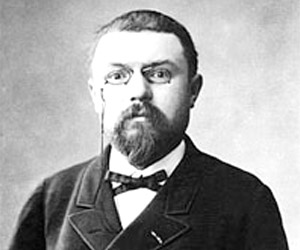Our Fifth Mathematician: Henri Poincaré
“Science is built up with facts, as a house is with stones. But a collection of facts is no more a science than a heap of stones is a house.” – Poincaré
Name: Jules Henri Poincaré
Born: 29th April 1854 in Nancy, Lorraine, France
Died: 17th July 1912 in Paris, France
Best Known For: Poincare Conjecture, The Three-body Problem, Topology.
Poincaré was born in 1854, in Nancy, France, to a very influential family. His father was a professor of medicine at the local University, his younger sister married the spiritual philosopher Emile Boutroux and his cousin, Raymond Poincaré became President of France in 1913, as well as being a fellow member of the Académie française.
Despite this high status and influence Poincaré’s family did not enter him in to a school until 1862, when he began attending he Lycée in Nancy. This was a result of Poincaré being seriously ill with diphtheria for a time in childhood, during which he received instruction from his mother, Eugénie Launois.
Poincaré was raised Roman Catholic but rejected religion in later life, and became an atheist.
During his education he proved to be one of the top students in almost every topic he studied. He mathematics teacher described him as a “monster of mathematics”. He did however suffer from poor eyesight and a tendency to be absentminded, which made music and physical education difficult for him.
After graduating the Lycée, Poincaré went on to enter the École Polytechnique in 1873, where he studied under Charles Hermite and published his published his first paper in 1874. After graduating a year later he began to study at Écoles des Mines and continued studying mathematics alongside mining engineering. Once he had graduated there e joined the Corps des mines as an inspector, and was on the scene of a mining disaster at Magny in August 1879, during which 18 miners died.
While working Poincaré was also preparing his doctoral thesis in the field of differential equation unde the supervision of Charles Hermite. For his thesis he devised a new way of studying the properties of differential equations, no only facing the question of determining the integral of such equations but also investigating their general geometric properties. It soon became apparent to him that these equations could be used to model the behaviour of multiple bodies in free motion within the solar system. He graduated from the University of Paris in 1879.
The same year Poincaré began teaching at the University of Caen in Normandy, though reports of his teaching were not wholly complimentary due to his disorganised lecturing style. In 1881 he left Caen and moved to the University of Paris, when he was offered a chair in the Faculty of Science. In 1881 he also married Louise Poulin d’Andesi, whom he later had a son and three daughters with.
In 1886 Poincaré was appointed to the chair of mathematical physics and probability at the Sorbonne, with the support of Hermite, and was also appointed to a chair at the École Polytecnique. He held all these chairs in Paris until his death at the age of 58.
It is difficult to discuss all of Poincaré’s numerous contributions to mathematics, including: being one of the founders of the field of topology, his research on the three-body problem leading to his discovery of the first chaotic deterministic system, which laid the foundation for modern chaos theory and his most famous Poincaré Conjecture, which remained unsolved until 2003 when Grigori Perelman sketched a proof over a series of thee papers.
Instead it is more interesting to discuss Poincaré’s methods for thinking, exploring new ideas and writing. He is considered one of the greatest geniuses of all time and two significant sources exist which study his thought processes. The first is a lecture Poincaré have to l’Institute Général Psychologique in Paris in 1908, which had the title “Mathematical Invention”. In this lecture he looked at his own thought processes which led to his major discoveries. The other sources is a book by Édouard Toulouse, written in 1910, entitled “Henri Poincaré”. In the book Toulouse discusses Poincaré strange schedule as well as his techniques and shortcomings. Toulouse said that while most mathematicians worked from principles already established, Poincaré started from basic principles each time.
In 1912, Poincaré underwent surgery for a prostate problem and subsequently died from an embolism on 17th July 1912 in Paris, at the age of 58. He is currently buried in the Poincaré family vault in the Cemetery of Montparnasse in Paris, though it has been suggested by former French Minister of Education Claude Allègre that he be reburied in the Panthéon in Pais, which is reserved for French citizens of the highest honour only.
Poincaré’s fantastic methods are well summarised thus:
“Accustomed to neglecting details and to looking only at mountain tops he went from peak to another with surprising rapidity, and the facts he discovered, clustering around their centre, were instantly and automatically pigeonholed in his memory” – Belliver (1956)
